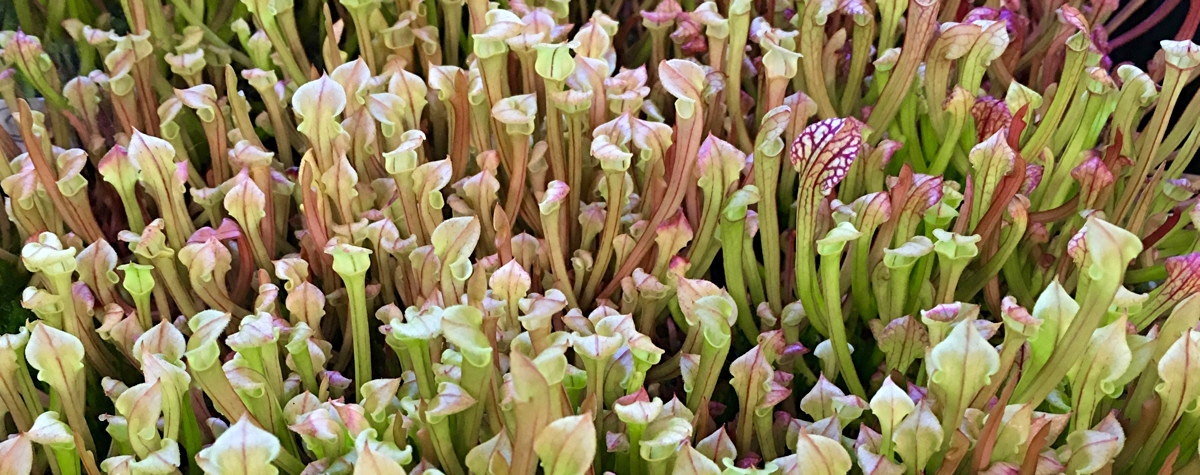
Six month old Sarracenia seedlings.
Sarracenia are fairly easy to grow from seed if you have patience. Each step in producing the seed, germinating it, and growing the plants takes patience. It takes at least 4 years to go from a just-pollinated flower to a mature, blooming plant. Don't even think about how old you will be or what you will be doing in 4 years. Just do it for the adventure.
Sarracenia seedlings make excellent indoor plants. For the first two years you can grow seedlings under lights without dormancy. In fact, if you give them enough light and enough food, after two years you will have plants the size of four-year-old plants grown outside with dormancy. It may even bloom in its fourth year of growth.
Pollination
Sarracenia flowers usually appear in the spring slightly ahead of or with the first pitchers. The very elaborate flowers do not self pollinate. They need certain species of bumblebees for pollination services. In many areas, there are no pollinators that know how to work the flowers or the plants bloom too early for there to be any pollinators around. If you don't pollinate the flowers yourself, it will not happen and you will not get any seeds. This can actually be good when you are doing crosses. You will not need to bag flower to keep them from being pollinated naturally. However, if you do have bumblebees that pollinate the flowers, you will need to bag flowers with a mesh bag if you want to make specific crosses.
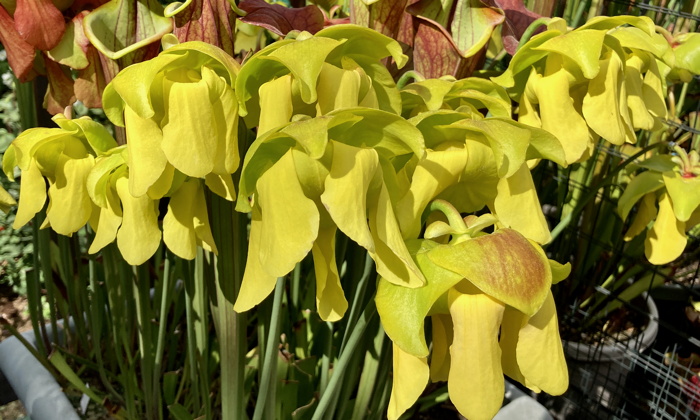
These flowers are begging to be pollinated. The flowers are a little darker yellow than typical Sarracenia flava because one parent of this plant has orange flowers while the other shows evidence of introgression from Sarracenia rosea.
Sarracenia flowers are constructed so that a pollinator must take a one-way route when visiting a flower. The entrances are under the sepals at the tips of the style. As the pollinator enters the flower, it brushes past a stigma (the pollen receptive part) which rubs pollen off the pollinator's body. After the pollinators push their way into the inner chamber, they have a jolly time rolling in the pollen and slurping the nectar. To get out, pollinators must push their way under a petal. This avoids pollinating that flower with its own pollen. Some of the pollen on the pollinators body will rub off onto the stigmas of the next flower visited.
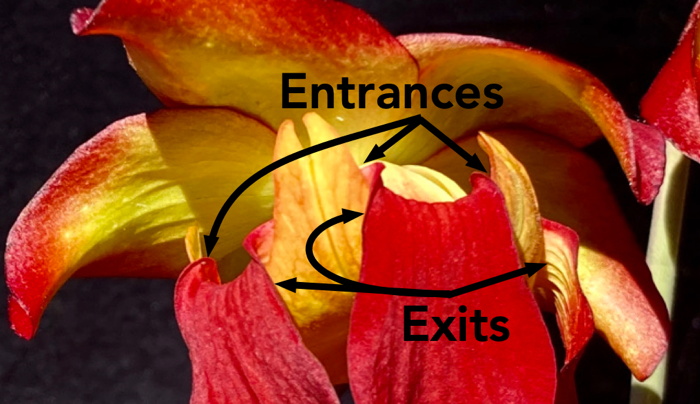
Sarracenia flower pollinator entrances and exits. There are 5 of each around the flower.
Generally, it is not a good idea to self-pollinate Sarracenia flowers. That is, to pollinate the flowers of the same clone with pollen of the same clone. Self-pollination can result in lower seed viability and a higher frequency of runt plants. This is a known problem with Sarracenia flava and other species may be affected as well. Self-pollination does occur in nature because if the plant has multiple flowers open, the same pollinator can visit all the flowers. If you have no other choice, do not expect great results overall but there should be some nice progeny from self-pollination.
Timing of when you do pollinations can be critical. Generally, in a Sarracenia flower the stigmas are receptive when the flower petals extend and before the pollen is released. The timing of pollen release is species, population, and clone specific. It can be the second day the flower petals are fully extended or it can be three or four days after. In the mean time the stigmas may only be receptive for a few days and that time may not overlap when the pollen is released by the stamens. This is a known problem for certain Sarracenia minor locations and it may be more widespread. The whole pollination process can be affected by temperature and humidity as well. The best advice from large breeders is to do pollinations on flowers that have been open one or two days. If you wait too long, the stigmas may not be receptive. Unfortunately, with the short time window to do crosses, it may be difficult to do some crosses you may wish to do. And if the weather is not cooperating during blooming, the crosses for the year may end up a bust unless the plants can be protected.
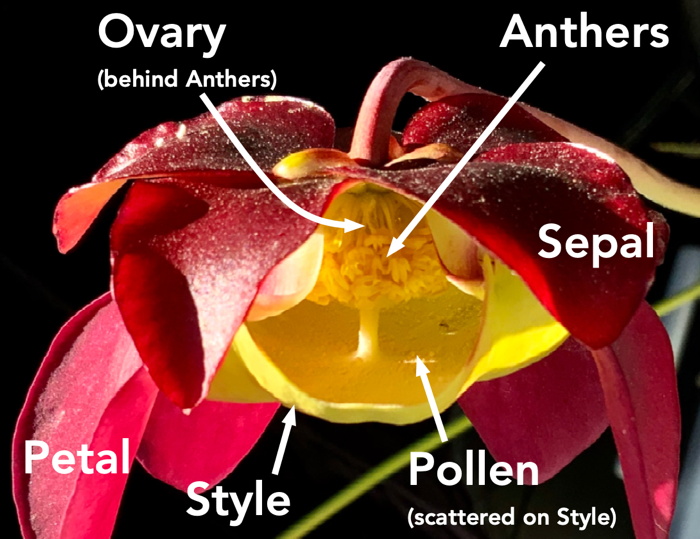
Sarracenia flower parts with a petal removed to see the stamens and pollen inside the flower.
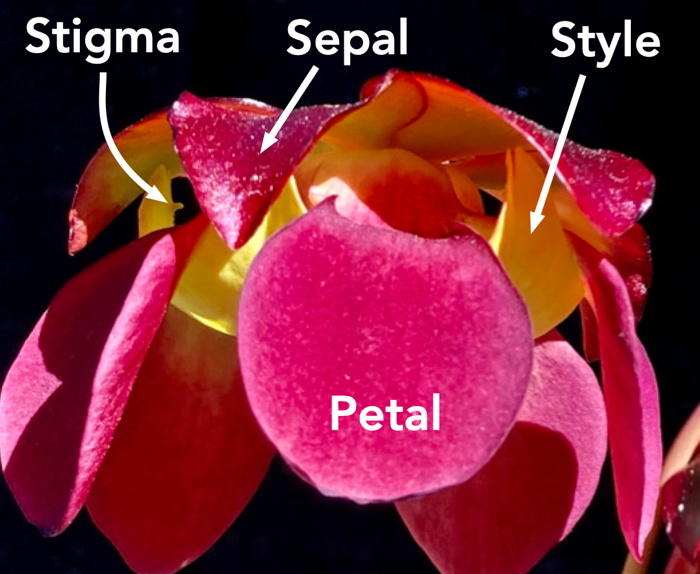
Intact Sarracenia purpurea subsp. venosa flower where you can see the nipple-shaped stigma where the pollen goes.
To see where you get the pollen to put on the stigmas, lift a petal of the flower. Inside you will see the pollen-bearing stamens hanging next to the ovary and piles of pollen on the style floor if it has been released. Use a natural bristle paint brush to get the pollen off the umbrella-like part of the style. Watch out for the nectar globules on the ovary as they will gum-up the brush. You can use this pollen immediately to pollinations. Some growers save the pollen for later. Brush the pollen onto a piece of aluminum foil, fold the foil to make an envelope, and place in a freezer. Or really load up the brush with pollen and wrap the end of the brush in foil. I am told the pollen will last in the freezer for a month or so. Since each species tends to bloom at a slightly different time, saving pollen is necessary to make certain hybrids.
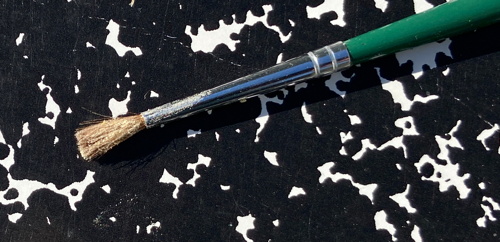
Inexpensive natural bristle brushes work best for pollination. Pollen will not stick to synthetic bristles. Trim the tip so it is blunt.
The stigmas are usually exposed but it helps to bend up the sepals to get the paint brush to them. Dab the stigmas with pollen and look to see if it is sticking. Sometimes the style points with the stigmas are a little deformed. You can waste a lot of pollen trying to get pollen to those stigmas.
Now that you have finished playing "bumblebee", you get to wait 5 months to see if your pollinations were successful and you get seeds.
You can collect the seeds before the capsules turn brown and split to get a few month's head start with the seedlings. I have done this but do not do it regularly because it is too easy to collect the seed capsules too early. If your plants bloom in April, you may be able to get viable seed from the capsules in mid August but it is best to wait until September. If your plants bloom in May and June, the seeds may not be ready until October or early November. If the capsules start turning brown, pick them immediately so the seeds won't be lost when the capsules split open. Put the capsules into a paper envelope to dry then carefully split them open and remove the seeds.
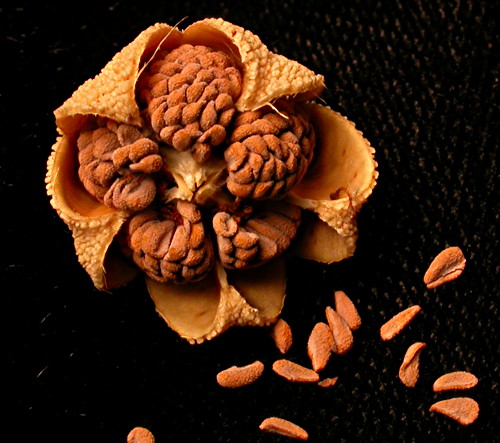
Sarracenia rubra seed capsule with ripe seeds.
Packets or envelopes of seeds should be stored in a sealed container in a frost-free refrigerator. Make sure that when the seeds are removed from the refrigerator, they are allowed to warm up to room temperature before the container is opened. Moisture is the bane of seeds. Water will condense on the seed envelopes and seeds if they are colder than ambient temperature. Properly stored Sarracenia seeds should be viable for at least a year, possibly two years. However, poorly stored seeds may lose viability in nine months. Start stratifying and planting the seeds as soon as you are able to do so.
Growing Sarracenia the natural way.
Most of the growing instructions on this page assume the young Sarracenia plants are grown in pots in trays of water under controlled conditions. Commercial and large scale growers tend to use heated greenhouses, possibly with supplemental lighting in winter, for young plants. Small scale home growers usually use an indoor space, basement, or garage with intense plant lights for starting new plants from seed. Under these conditions, it is possible to get plants that bloom in 31/2 years from when the seeds start stratification. However, there is nothing wrong with starting Sarracenia from seeds the natural way. It may take an additional two or three years to get blooming size plants depending on your climate.
If you live in an area where Sarracenia grow naturally or where they could if there were appropriate habitat, you can ignore all that follows and just plant your seeds outside in the fall in 15 cm (6 inch) or larger pots filled with a peat/sand mix and let nature takes it course. You should probably protect the seeds and seedlings from heavy rain until the plants get established. Consider using the tenting method used at the Meadowview Biological Research Station. Make sure you use rain, reverse osmosis, de-ionized, or distilled water if there is even a moderate amount of dissolved solids (salt) in your tap water (Usually surface derived water is OK; well water is iffy. Check the water quality report from your water company or city. Total dissolved solids below 100 ppm is best.) Sarracenia is a very sturdy plant within its natural climate zone.
Germinating seed
Sarracenia seed is rather odd. It has a waxy coating making it hydrophobic, most likely to help with dispersal in nature by floating on water. This also makes it difficult to germinate quickly. The seed can't germinate until you get moisture past the wax and seed coat into the embryo. You waited how many months to get the seed and you want the plants NOW! Relax.
There are all sorts of claims about quick methods of germinating Sarracenia seeds. DON'T WASTE YOUR TIME OR SEEDS. Yes, you will get some germination but to get good germination you need to properly stratify the seeds.
The tried and true way of germinating Sarracenia seed is to cold stratify the seed for 4 weeks (5 weeks for Sarracenia purpurea subsp. purpurea). Storing the seed dry in the refrigerator isn't stratification. Stratification is storing the seed in a cold and damp environment usually with natural materials that may aid the process of convincing the seed it is time to start growing. The easiest method is to refrigerate seeds in a small plastic bag with a few strands of finely chopped sphagnum moss dampened with purified water. Live sphagnum is the best choice. The moss should be wet enough so that if you squeeze it you will see water but there shouldn't be any free water in the bag. If you don't have live or dried sphagnum moss and must use peatmoss, get it very wet then squeeze it to remove most of the water and make sure there is plenty of air in the plastic bag. The seeds need air.
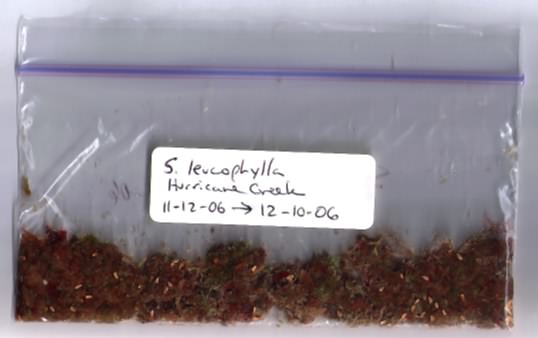
Sarracenia seeds stratifying in finely chopped live sphagnum moss.
A few words about soils for Sarracenia.
Sphagnum moss is generally recommended as the best medium for Sarracenia. Sphagnum moss is hard to find, very expensive, and not always harvested in a sustainable manner. Quite often moss sold as Sphagnum is actually a sheet moss that can be problematic for growing Sarracenia.
Soil mixes with peat are more than adequate for Sarracenia. In fact Sarracenia rubra, S. psittacina, S. rosea and most hybrids prefer being in a peat mix. Keep in mind though, with a peat mix you need to top water the plants and change the water in the trays occasionally. How often depends on your water quality, how often you water your plants, and exactly which mix you use.
The most common peat mix is equal parts peat and silica sand. The peat needs to be sphagnum peat which is decomposed sphagnum moss. Try to get horticultural grade peat. The peat typically found in garden centers is everything but horticultural grade if it comes from a company that sells different grades of peat. If you can't get horticultural grade peat, consider brands that specialize in potting soil mixes based on peat. The sand should be fairly coarse and about the same size grains. With fine particle sand, the soil can become like concrete. Sieved, coarse, washed "play sand" can work. Horticultural sand and 12 to 16 mesh silica sand blasting sand are best. Sand may need to be soaked for a while in purified water to help remove the salts. The salt gets into the sand during processing because water is sprayed on the material to reduce the dust. Breathing silica dust from sand is dangerous to your health.
Many members have great success using perlite instead of sand in their soil mixes. For others it can be disastrous. The differences seem to be whether the perlite itself is salty or has added fertilizer. It is important that pots with perlite get top watered regularly or are allowed to get rained on. If you do use perlite, and I do, absolutely make sure there is no fertilizer added to the perlite. The usual suspects for adding fertilizer are companies that also sell fertilizer. The fertilizer cannot be easily washed out. Also when using perlite, keep it wet or damp because breathing perlite dust is very dangerous to your health. I pour water into the bag of perlite to keep it damp.
Another method for stratification is to sow the seed directly in pots and store the whole pot in a plastic bag or a tray of pots under a humidity dome. The pots with the seeds can be stored in a refrigerator or outside during the winter in a cold garage or other location that stays around refrigerator temperature and is out of the sun. It is OK for the pots to freeze as long as the seeds have not germinated. However, the time frozen does not count toward the four weeks. Seeds planted outside in unprotected pots have a tendency to wander into adjacent pots.
After stratification, sow seed on a peat mix in conveniently sized pots. If you stratified the seed in a plastic bag, spread it over the medium in the pots with your planting spoon. You can use any convenient size pot. Place the seed about 5 mm apart and use a number of pots to keep from having all the seed in one pot. I cover the seeds with sand, about one or two layers of sand deep. Please see Sowing Seeds Step-by-Step for more details on starting seeds.
Put the pots with seeds in plastic bags or under a humidity dome under LED lights. Don't put the bags or domes in direct sun. A temperature of 20° to 25°C (70° to 80°F) is ideal. The seeds should germinate in 2 to 4 weeks.
After the seeds germinate and you get a few true leaves, the pots can be removed from the plastic bags or from under a humidity dome. However, you may find it more convenient to keep them under a humidity dome because the pots should never dry out. The pots with the seedlings can also be put in a greenhouse. A sunny window is not enough light. Putting the seedlings outside can be problematic without some sort of protection from inclement weather and creatures.
Growing juvenile plants
Juvenile Sarracenia can be raised indoors under lights for two years. They need at least 25W of white LED lighting per square foot or 15W of colored (purple or red/blue) LED plant lighting per square foot. The lights should be on for 16 to 18 hours per day. Some growers leave the lights on constantly for the first year and report good results. For the second year, the plants should be on a natural light cycle in sync with the local sunrise and sunset. Use a timer that turns on the lights at local sunrise and off at local sunset. This is important because the plants can lose a year of growth if they are seasonally out of sync when transferred outside.
As the plants grow too large and become crowded in the pots, they will need to be transplanted into larger pots or fewer plants per pot. A good time to make a first pass on keepers is when the plants are one year old. You may need to do it earlier if you planted too many seeds in the pots. After a year and a half, some plants may need to be in 9 cm (3 to 4 inch) pots by themselves, so make sure you have a large enough growing area.
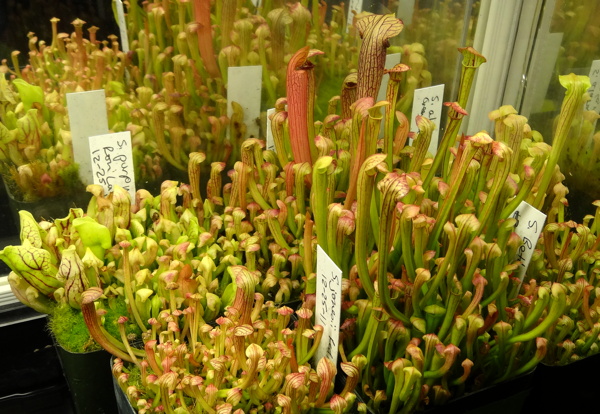
It is common that there is variation among the seedlings within a seed lot. There can be plants that are exceptionally large. There usually are plants that will always stay small and/or grow very slowly. Some of the larger plants can be from accidental hybridization. There have been situations where growers wanting pure species kept the larger, accidental hybrids and tossed the real deal. Some taller plants can be what you want in terms of species or hybrid but have poor form because the pitchers get tall and skinny and fall over. Commercial breeders raise out thousands of plants to find best ones to carry forward. (Hint for newbies: in winter, some large nurseries have sales to unload excess dormant plants from their breeding operations. This can be a great way to start a collection to gain experience in growing Sarracenia.)
Feeding and fertilizing seedling and juvenile Sarracenia
Indoors or in a greenhouse that stays between 15° to 32°C (60° to 90°F) year round you can push your Sarracenia to grow more quickly. The key to pushing Sarracenia is soil fertilization and pitcher feeding. You can soil fertilize seedling and juvenile Sarracenia if you are careful. Some species such as Sarracenia leucophylla are more sensitive to fertilizer than other species so there is no one size fits all. Commercial growers put fertilizer in the water for their plants. Each grower has their own secret protocol. Even if you know the parts per million of nitrogen and other nutrients they use, it isn't helpful because they have optimized the whole process for their grow space and convenience. There is no reason you cannot find the optimum procedures for your own grow space. Just keep in mind it is very easy to over fertilize the plants. I have. Fertilize one time too many or with a fertilizer solution that is too strong and you can do serious damage to the plants and defeat the purpose of using fertilizer. If you do burn the plants with fertilizer, repot them into new soil immediately. I do not find foliar feeding useful unless it is really soil fertilization in disguise.
You can safely fertilize the soil with high nitrogen Osmocote™ Smart Release® Plant Food. For a 9 cm (31/4 inch) pot evenly place 4 to 6 pellets about 3 cm (1 inch) below the soil surface after the seedlings have a few pitchers. You may want to start with 4 pellets, add 2 more a few months later, and 2 more after a few months again. Keep a careful watch on the plants to make sure you have not put in too many. The plants do tend to put out pitchers in flushes. Each flush should be significantly larger than the previous one. It is quite exciting when the pitchers are doubling in size every few months. More pellets can be added when the plants are repotted when they are one year old. There is nothing magic about Osmocote™. It is just an easy way to fertilize and to know exactly how much fertilizer you are using. Also, don't grow the soil fertilized plants in the same water trays with other carnivores unless they also like soil fertilization. The fertilizer leakage from the Sarracenia pots will soil fertilize all the plants in the tray.
When the plants get large enough, you can start putting dried blood worms (fish food) in the pitchers. I tent to put the worms in dry and then spray a little water into the pitchers. Putting in rehydrated worms with a little extra water may be better but is more work. It is better to do a little bit multiple times to keep from burning the pitchers (indigestion) and overfilling the pitchers with water which will cause the them to fall over. Putting dilute fertilizer in the pitcher is equivalent to soil fertilization since the plants pump water and fertilizer out of their pitchers and into the soil.
Transitioning juvenile plants to be outside with the adults
Obviously, if you grow all your plants in a greenhouse, there are no worries about transitioning plants from indoors under lights to outdoors under natural conditions. However, if you do grow the young Sarracenia indoors, when and how to move them outside can be tricky. The best time is about the time the outdoor plants are blooming in the spring. If it is cold, they will pause their growth until it warms up. If there is a threat of frost, move them back in until the threat passes. If it is hot and sunny, the plants will need a little shade to keep the pitchers from burning. It is always hard on plants shifted between extreme environments.
I find soil fertilization of adult Sarracenia is problematic, verging on dangerous, although many commercial nurseries do it. It is OK to soil fertilize plants in their third year. I do not do it because it causes too many problems with the soil. I get better results from rehydrated dried blood worms in the pitchers.
If all goes well with adequate warmth and light, the right amount of fertilizer, a smooth transition to outside, and being fed well during the third year outside, some of the plants will bloom at the start of their fourth year.
-- John Brittnacher
December 2011
Latest Update June 2021
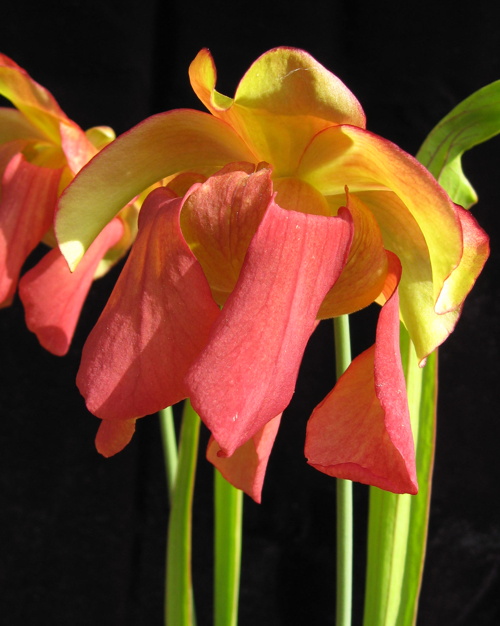
Sarracenia flower. Species flowers are red, yellow, or greenish. This is a hybrid.
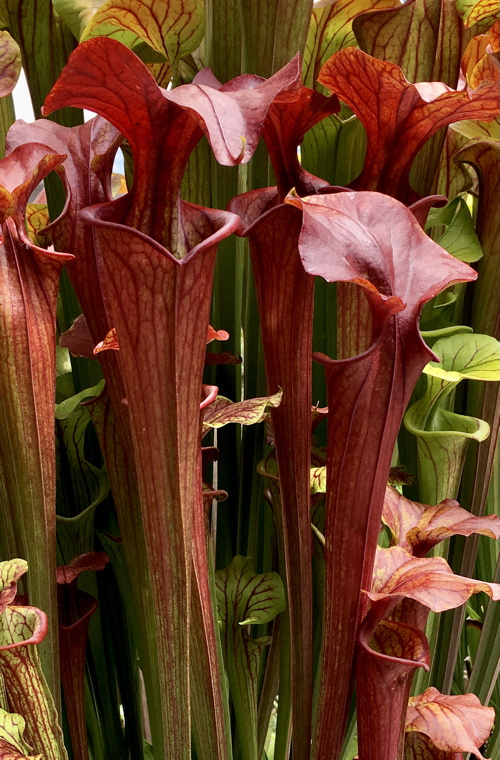
Not happy with how your Sarracenia flava var. atropurpurea plants perform? Make your own all-red fake-atropurpurea hybrids. The parents of this plant are Sarracenia flava-dominant, complex hybrids with unknown parentage.
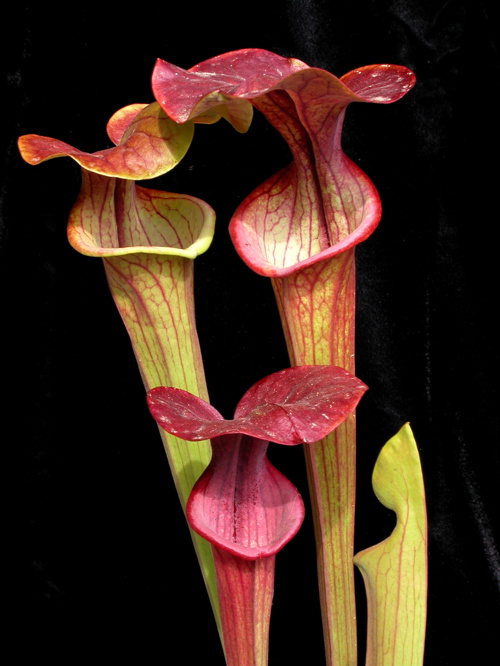
A nice hybrid Sarracenia oreophila x a supposed Sarracenia flava var. atropurpurea.
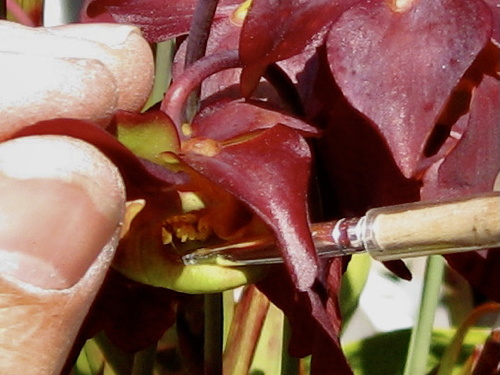
Lifting a petal to collect pollen from Sarracenia jonesii.
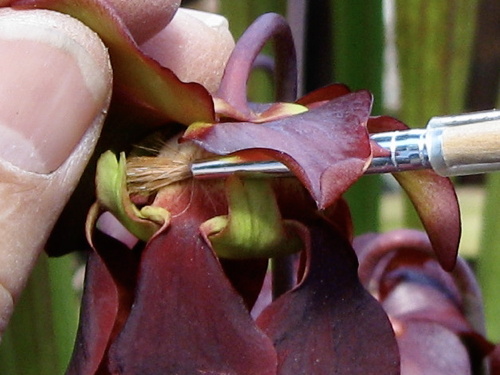
Lifting a sepal on a different Sarracenia jonesii clone to put pollen on the stigma.
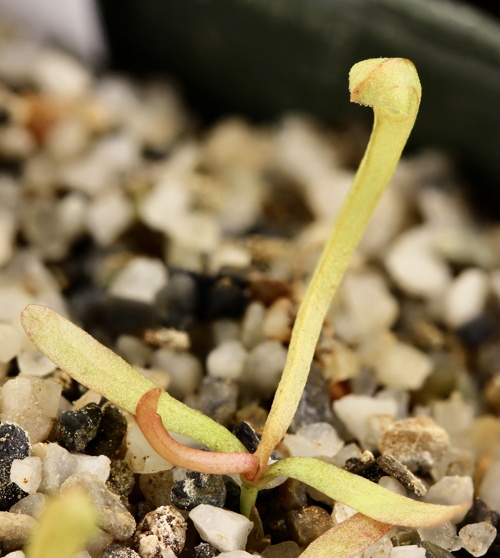
Sarracenia sprout. The first true leaves are pitchers.
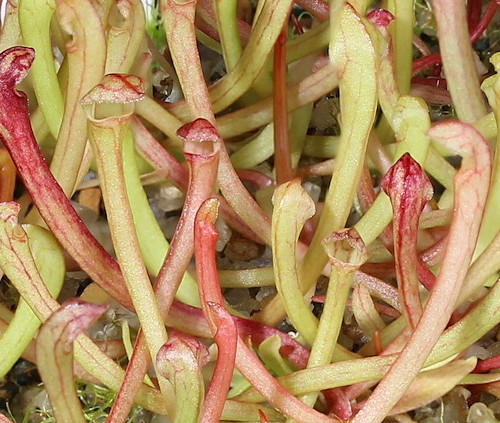
Sarracenia seedlings a few months old.
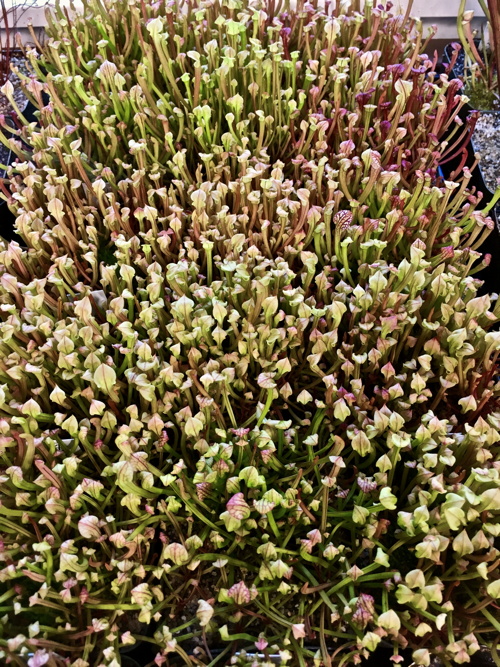
Way too many seeds were planted per pot in this tray of seedlings. The plants were not as large as would be expected otherwise. However the plant below was selected from this tray of seedlings.
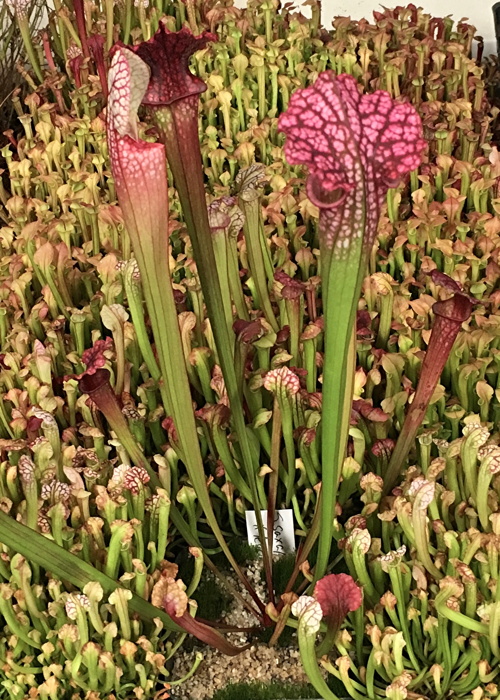
An exceptional Sarracenia plant from this tray of one year olds. It was potted out separately to help it grow faster.
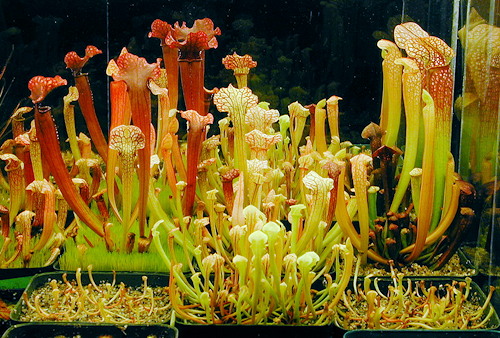
Sarracenia seedlings and yearlings grown indoors under lights. This terrarium has mirrors around it to reflect light diagonally so the pitchers get better light. It also makes it look like you have twice as many plants!
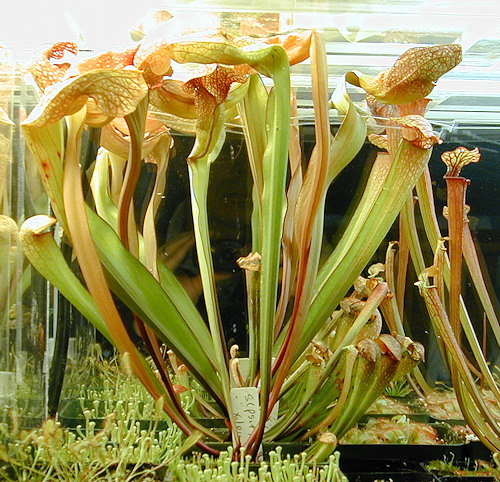
Max headroom is a major concern with Sarracenia indoors. These three year old plants put on a tremendous growth spurt.
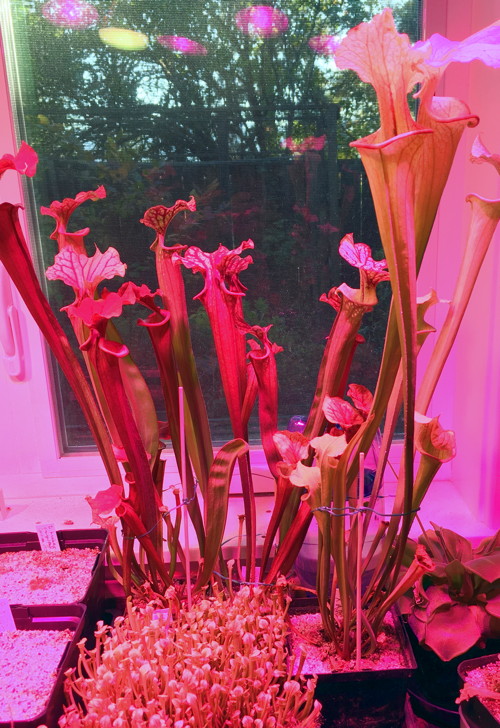
Two year old Sarracenia grown under purple spot plant lights. The plants got intense light plus were soil fertilized and fed in the pitchers with rehydrated dried blood worms. Nine month old plants are in the foreground. As usual, they are too crowded.
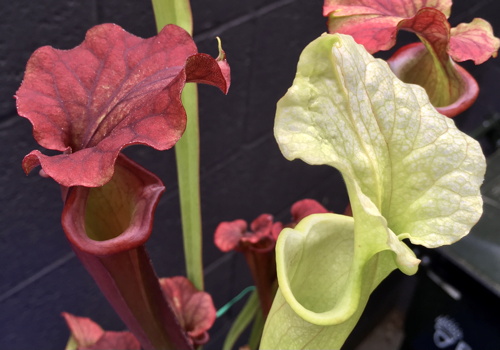
These two year old plants are siblings. This is why you grow your own plants from seed.
